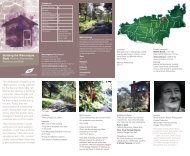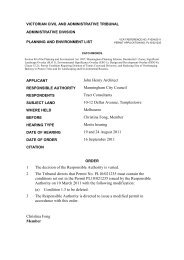Weeds Identification (PDF, 13MB, new window) - Manningham City ...
Weeds Identification (PDF, 13MB, new window) - Manningham City ...
Weeds Identification (PDF, 13MB, new window) - Manningham City ...
You also want an ePaper? Increase the reach of your titles
YUMPU automatically turns print PDFs into web optimized ePapers that Google loves.
Creeping Buttercup<br />
Ranunculus repens<br />
Status:<br />
Very serious environmental weed<br />
Found in moist sites in pastures, gullies, streams<br />
Features: Perennial herb with creeping runners<br />
and leaves on long stalks. Leaf blades divide into<br />
three lobes, which are toothed and divided further.<br />
Bright yellow flowers from winter to spring. Seeds in<br />
summer.<br />
Dispersal: Spreads by seed and stolons, dumping<br />
of plants, altered drainage and grading of roadsides.<br />
Spreads readily into poorly drained and permanently<br />
moist areas.<br />
Related weeds: R. trilobus (Large Annual<br />
Buttercup); R.muricatus (Sharp Buttercup).<br />
Control:<br />
English Ivy<br />
Hedera helix<br />
Status:<br />
Very serious environmental weed<br />
Garden escape<br />
Found in moist sites, gullies and streams<br />
Features: Woody, perennial plant, climbing to 30m<br />
and/or creeping along the ground and forming<br />
carpets. Shiny, triangular, lobed, dark green leaves<br />
with pale veins. Yellowish-green flowers, only on<br />
climbing parts in late March, followed by black fruit.<br />
Note: Leaves look different on flowering parts of the<br />
plant. Climbing plants will kill trees in the long term.<br />
Spray treatment requires special permission and<br />
can only be carried out by a professional.<br />
Dispersal: Readily regrows from small stem pieces.<br />
Seed spread by birds, foxes.<br />
Control:<br />
Climbers and Creepers<br />
13










